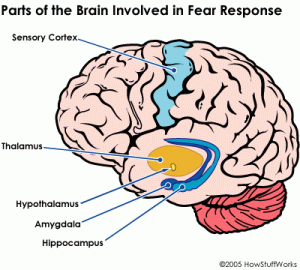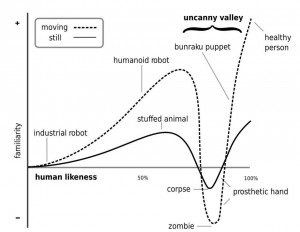It’s just your average scary movie night. You’re sitting on the couch, your knees held tightly to your chest, and your eyes barely peeking over them. The room is dark, and as you watch the screen, you mumble “don’t go in there”. Your palms are sweaty as the music grows eerier and more suspenseful by the second… and… “AHHH!” a pop up nearly stops your heart. What is the science behind this intense feeling we call “fear”?
Your brain gives off immediate stimuli and fear just so happens to be one of them. In fact, being afraid of things, and our body’s natural tendency to react is one of the reasons why we’re still alive today. It is easy to understand why we are afraid of things such as poisonous insects, and animals that can harm us. But, why are things scary if they simply pose no possible threat to us … such as scary movies, or creepy dolls. According to this video I watched , things like masks and clowns can be scary due to the fact that they are vague, or are ambiguous. These masks hide the social interaction between others and eliminate normal emotion. Often, scary movies use masks to scare their viewers partially because one can not tell if the person under the mask can possible threaten, or harm them. This is an example of ambiguity. This gives you a creepy vibe due to a hypothesis called Uncanny Valley. Masks fall under this category because they are almost identical to a human, but are the slightest bit off; making it creepy.
Let’s talk about the brain. Going back to the jump scares and the creepy music in movies, I want to address the fear of loud sounds, and how that has a fearful effect on your brain. While most of your fears are learned, our body reacts to loud sounds innately. These loud sounds triggers your body into a fight or flight mode, releasing epinephrine into your system. Here is where I learned how the body processes fear, like loud sounds. Your amygdala has a key role in triggering fear because it’s primary role is memory, decision making, and emotional reactions. The amygdala shoots messages to your brain telling it that something’s wrong and in response, your body prepares itself for the worst. So whether the “scary” thing is a suspense filled movie, a loud pop up scare, or simply a spider, your body reacts the same way. Once those chemicals are released, your body tenses up; making your palms sweat, your muscles tighten up, and your heart race like no other. This is an autonomic response . We are not consciously aware what is happening. There are myriad parts of the brain that help trigger this fear, not just the well known amygdala.
 The Thalamus, Sensory Cortex, Hippocampus, and Hypothalamus all work together to send messages to your brain that you are in danger, or “scared”. So next time you get the creeps when you see someone in a mask, or jump out of your seat at a pop up in a movie, just remember that it’s just your body’s natural reaction to keep you safe.
The Thalamus, Sensory Cortex, Hippocampus, and Hypothalamus all work together to send messages to your brain that you are in danger, or “scared”. So next time you get the creeps when you see someone in a mask, or jump out of your seat at a pop up in a movie, just remember that it’s just your body’s natural reaction to keep you safe.



Very interesting post! I found this article which also explains what happens to our brains when we are scared. It also includes a scary video at the end just in case you want to check your responses. http://www.techinsider.io/what-happens-when-you-are-scared-2015-10
This topic really interested me because I have come to realize that I am scared of so many things and the majority of them are irrational. For example, I am terrified of birds, but I have never had a bad experience with them. Your post helped me learn this reaction must be triggered because of my amygdala.